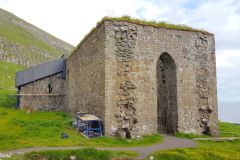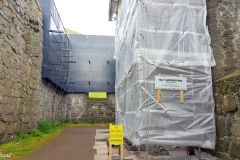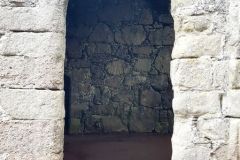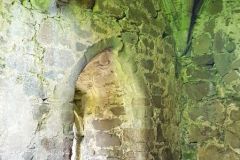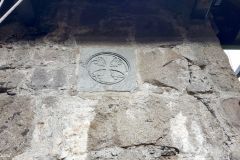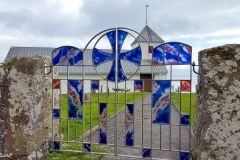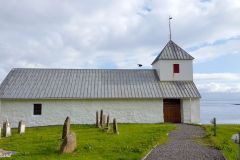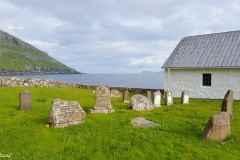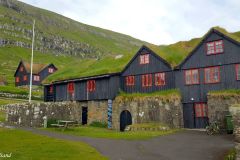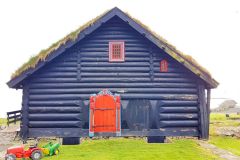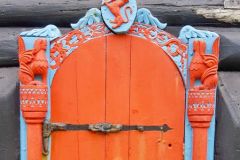Kirkjubøur is the most important historic place on the Faroe islands. In Medieval times this was the religious and cultural centre of the Faroes. Here we find the ruins of the St Magnus cathedral dating back to around 1300, the even older St Olav’s church (still standing and in use) and also one of the world’s oldest inhabited log houses.
The St Magnus cathedral
After the Faroe islands were Christened gradually after 1000 AD, Kirkjubøur was set up as the seat of the diocese. They built a residence for the bishop and also a cathedral. According to tradition there was never a roof on the cathedral, but recent research suggests otherwise – and all likelihood points in the same direction.
Anyway, in the years after the Reformation the St Magnus cathedral was left to rot and was even deliberately dismantled. In 1772 an avalanche crushed the northeastern part of it. Without a roof, windows and doors, the strong forces of nature produced over the centuries a ruin. Have a look at this drawing from 1839. From being viewed as one of the finest churches of the Nordic countries the ruins are now simply called Múrurin (the Wall). The Gothic archways are still impressive.
In recent years an ongoing conservation project has sought to stop the deterioration and preserve the ruin like it is, a ruin. After the Reformation the interior moved elsewhere, and some of it is on display in Tórshavn.
The St Olav church
The Faroes were partly inhabited by Irish monks seeking solitude. Pagan Vikings came by and drove them out. Later, some years before 1000 AD, converted Norwegian Christians arrived. They fought hard to persuade the population to renounce their faith in Odin, Thor and the rest of the gods of the ancient Norse mythology. A very early church was built here at Kyrkjubøur, and the remains of it has been found under the present-day Ólavskirkja.
The St Olav Church is located next to the former cathedral. It is alive and well preserved. Built as early as 1111 AD it is still in use as a parish church, the only from the Middle Ages on the Faroes. If you take a closer look you will find that it is made of rough unhewn stone, plastered and then white-washed.
It was built at a then presumably safe distance from the seashore. As the centuries went by, the sea gradually ate up much of the shore. By the end of the 19th century it was in danger of being washed away. A bulwark was set up at the time. It has kept the church intact and will hopefully do so for many years to come. A small cemetery surrounds it on three sides.
I did not manage to get into the church on my visit. However, the story goes that it has gone through several changes over the years. Much of the internal furnishing is now on display on Tórshavn, at the National Museum (Føroya Fornminnisavn).
The Kyrkjubøur farm
Legend has it that Kirkjubøur was given to Bishop Orm by Gæsa Sigursdottir, one of the most powerful women at the time, as a penance for her having eaten meat during Lent. Gæsa allegedly moved to the island of Vágar in the west, where she founded the village of Gásadalur.
Legends or not, the fact is that after numerous bishops had resided here at Kirkjubøur under the auspice of the Holy Pope in Rome, the King in Copenhagen decided otherwise. The Reformation in the Nordic countries led to the confiscation of all church assets. The King’s farm in Kyrkjubøur became the largest in the Faroes. The farmhouses we now meet, painted black with red window frames, are not all Medieval. The Roykstova is however very old and some reckon it as the oldest inhabited wooden house in Europe, even in the world.
The story is that it was built in the Sognefjord, Norway, dismantled, and shipped across the sea to Kirkjubøur to be rebuilt. (Other sources indicate it was built of driftwood from Norway, but this does not seem very likely as the main current goes in the opposite direction.) Note the heavy stone foundation beneath it.
.
The Faroe islands are almost treeless. Hence, one might speculate as to why one would build houses like this of wood, rather than stone. In fact there are many wooden houses around the Faroe islands, unlike, say Scotland and the other islands in these rough waters. The reason might by that the local chieftains and bishops did this because they could afford it. Wood was scarce, therefore expensive. If you would want to flash your wealth to the surrounding world, wooden buildings would settle the score.
In addition connections with tree-rich Norway were tight. The Norwegian King Sverre I was born and brought up here in Kirkjubøur after his mother sought refuge from hostile foes at home. Note also that the carved entrance to the Roykstova is decorated by the Norwegian coat of arms, the lion. Unfortunately that was as far as I got during my visit as the museum had closed for the day.
The Roykstova (literally meaning smoke room) was a room with a central fire with a hole in the roof the let the smoke out. This was the traditional living, working and dining area. It was built on the structure of the former bishop’s palace and used to be larger. After the Reformation the Patursson family owned Kirkjubøur through 17 generations. Today however the property is formally owned by the government, with the Paturssons living here as tenants. One of them, Jóannes Patursson, was a prominent figure in the independence movement on the Faroe Islands from 1888 to 1946.
What more?
Horses and sheep graze the green hillsides of Kirkjubøur today as they have done for more than a thousand years. This place has remained central in the eyes of the Faroese people and is today a protected environment. Foreign dignitaries are often taken to roykstova, and the rest of us commoners will likely find our way during our visit to the islands as well.
The turf-roofed farm buildings, the newer residential houses and the churches (there was even a third church) of Kirkjubøur are situated southwest on Streymoy, the largest of the Faroese islands. Right across the Hestfjørdur we can easily spot the much smaller islands of Hestur and Koltur. I went there on a day trip from Tórshavn.
The hamlet of Kirkjubøur is accessible by public bus (no 101), a two-hour hike across the mountain or a 15 minute drive out of Tórshavn. There is a small ferry port called Gamlarætt a few minutes north of Kirkjubæur. There you will be able to find ferries to Hestur and Skopun (on Sandoy).

Yes, Kirkjubøur is not only a place of historical significance but also a place to live today.
What to explore on the Faroes?
Explore the map below. You may zoom in and out, and click the markers for some more information. I made it before going to the islands. Then I added more sites and attractions as my four days and nights in 2016 went by.
Find lexical information about the archipelago on Wikipedia. Read tourist information at Visit Faroe Islands, Faroe Islands Tourist Guide, and on international websites like Lonely Planet and Wikitravel.
This series from the Faroe Islands consists of several posts.
(1) Introduction
(2) Tórshavn, the nicest little capital in the world
(3) Medieval Faroese history at Kirkjubøur (THIS)
(4) A boat trip to Hestur, Koltur and a concert in the caves
(5) Attractions on Eysteroy, Borðoy and Viðoy islands
(6) Attractions on Streymey and Vágar islands
There is also a video from this visit in 2016.


